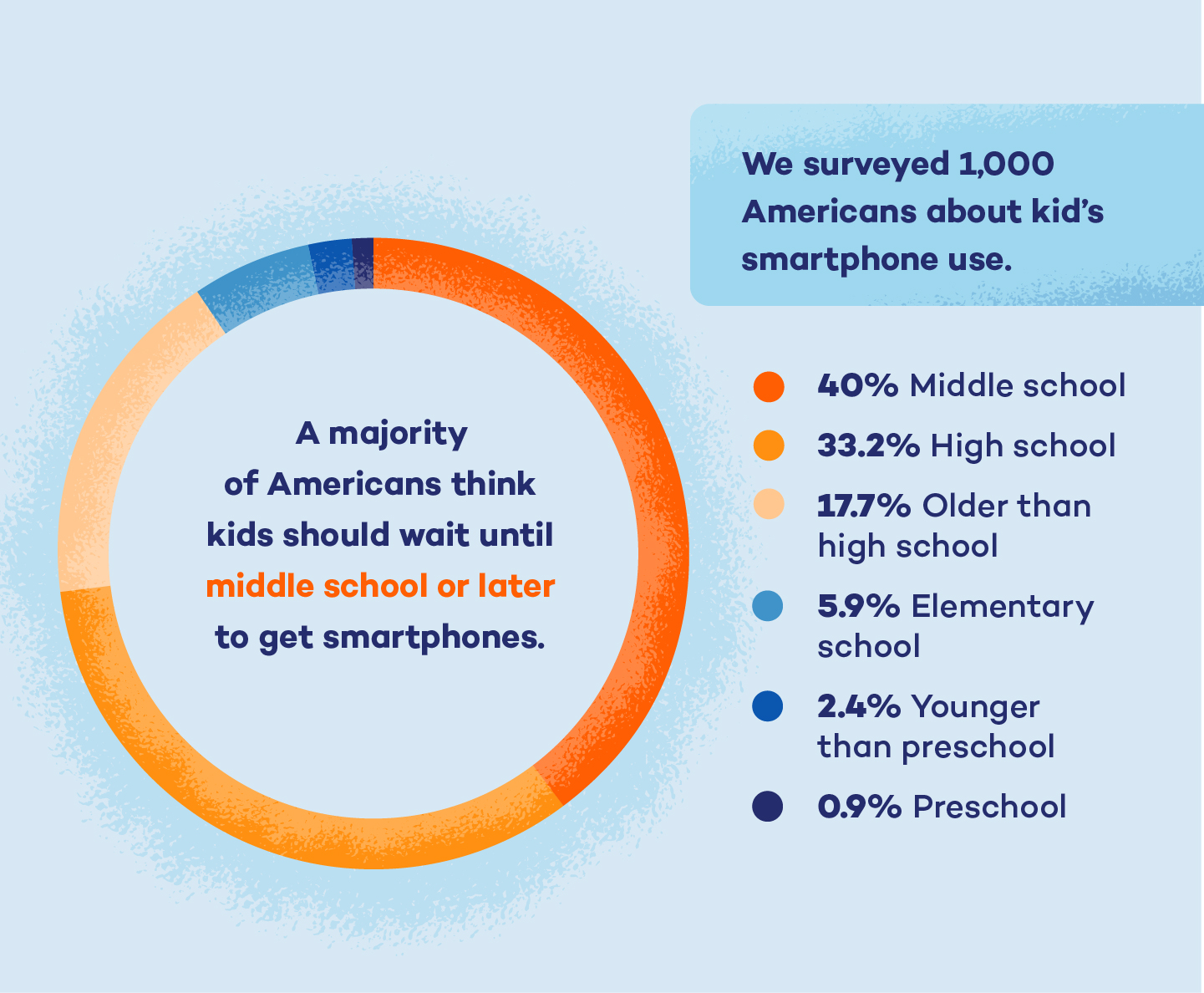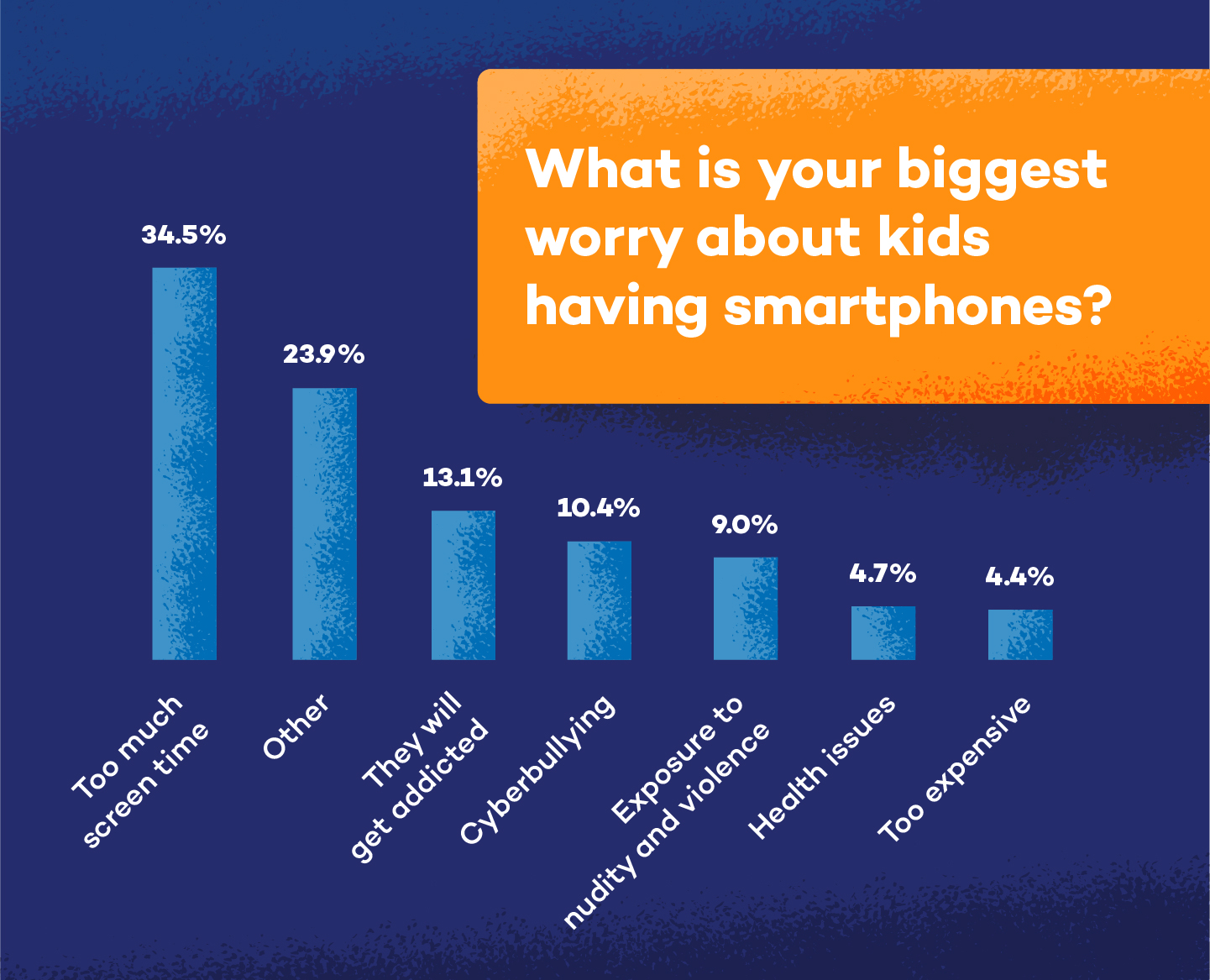These days, it’s not uncommon to see kids with their eyes glued to smartphones when eating out at a restaurant or attending local events. The digital age is upon us and these Gen Z individuals have never known a time without the Internet. Now, with the power of the Internet at their fingertips, parents have to consider an important question: “When should kids get smartphones?”
Jump to the infographic.
When Should Kids Get Smartphones?
Everyone has a different style of parenting, and as kids grow up in a digital age, technology will undoubtedly influence parental decisions. To help us better understand the trends in these decisions, we asked a group of 1,000 Americans, including men and women of all ages, when kids should get smartphones.
The results showed that 40% of Americans think kids should wait until middle school (age 11–13) before getting smartphones.
Close behind, one-third of the respondents said that parents should wait until high school to give their kids smartphones.

Although a majority of people think kids should wait to get smartphones, this isn’t necessarily the reality of today’s world. Surveys have shown that the average age kids get cell phones is 10 years old. It has also been reported that 25% of kids under the age of six have phones and half of them spend up to 21 hours a week on them. This trend of kids getting smartphones before they are ready is a cause for concern.
What Are the Concerns of Kids Having Smartphones?
There are many fears when it comes to giving kids their own smartphones. To find out the main concern of kids having smartphones we asked a group of 1,000 Americans what their biggest worry is.
A third of the respondents cited too much screen time as their biggest worry about kids having smartphones.
As you can see below, the additional responses varied between smartphones being addictive, the potential for cyberbullying, exposure to nudity and violence, health issues, and other concerns.

The Dangers of Too Much Screen Time
The fact that people are more concerned with their kids having too much screen time than they are with exposure to nudity and violence goes to show the severity of this issue. Too much screen time can contribute to many negative effects such as obesity, sleep problems, behavior problems, education problems and increased violence.
Common Sense Media reports that American children aged zero to eight use screen media for an average of 2 hours and 18 minutes per day. 35% of this screen time is spent on mobile devices. This amount of screen time is over twice the daily limit that the American Academy of Pediatrics recommends for children aged two to five years old.

Brain Development and Smartphones
Screen time also impacts the brain development of children. Analyzing kids by age can help us gain insight into how their brains develop and the impact smartphones might have on the process.
Ages four to six (preschool and younger)
This is a time when young brains are still developing. Screens on mobile devices cause overstimulation, producing dopamine and adrenaline in the brain. This makes them highly addictive at this age. In addition, this age group is just starting to learn social skills that should be taught in person rather than on a screen.
Smartphone use at this age isn’t suggested and should be limited. The respondents of the survey back up this belief, with only 3.3% responding that kids should get smartphones at preschool age or younger.
Ages seven to eleven (Kindergarten – 5th grade)
At this age, kids are starting to gain independence. They are at school all day and joining extracurricular activities after school. This independence may cause parents to consider getting a phone to keep track of their child.
However, this is also an age when bullying may start to become an issue and phones with Internet access and social media can contribute. These sites promote an over-reliance on peer validation and can have a negative impact.
Ages 12 to 14 (middle school)
The transition to middle school is one that is often done with a smartphone. 40% of survey respondents agreed that this was the best age to introduce this technology to kids. In terms of brain growth, this is a time when adolescents are developing skills like problem-solving, critical thinking and impulse control. If these skills can be seen in a child, they are probably ready for supervised smartphone use.
The founders of this technology also agree with waiting to give kids possession of a smartphone until they are older. Co-founder of Apple, Steve Jobs, reportedly limited his kids’ use of technology and prohibited them from using the iPad when it was released. Former CEO of Microsoft, Bill Gates, waited until his kids were 14 to give them phones.
Ages 15 to 18 (high school)
Although a high schooler may think they are fully grown, their prefrontal cortex still needs 20% more growth. The prefrontal cortex controls cognitive function and can influence planning, organization, impulse suppression and weighing consequences. Add in hormones and these high schoolers can be unpredictable.
Technology in this mix can be a cause for concern, especially when smartphones provide unsupervised Internet access. It’s important that parents teach and model good smartphone habits that their high schoolers can pick up on. Monitoring smartphone usage is also an important factor.

Teaching Smart Phone Use
Regardless of what age you decide to give your child a smartphone, it’s essential to teach smart phone use. Kids should understand the responsibility of having phones and what will happen if they abuse the privilege.
Suggestions for teaching smartphone use:
- Start by giving your child a cell phone that doesn’t have Internet access.
- Choose when to give them a phone based on how mature you think they are rather than when everyone else their age is getting one.
- Openly discuss the dangers of smartphones.
- Create a family contract that establishes smartphone rules and sets a consequence for breaking the contract.
- Set parental controls on the device.
- Monitor your kids’ screen time (most devices have a feature that tracks this).
- Set aside family time without technology to encourage human interaction and non-digital learning.
Smartphones have many benefits if used properly. Following these tips will help you decide when your child should get a smartphone and help ensure they use the device in a safe manner. For added protection, try Panda Security’s antivirus which offers a parental control feature so you can manage your child’s Internet use and app access.
Methodology:
This study consisted of two separate questions conducted using Google Surveys. The sample for each question consisted of no less than 1,000 completed answers. Post-stratification weighting has been applied to ensure an accurate and reliable representation of the total population. The survey ran in May 2019.
Sources:
Verywell Family I American Academy of Pediatrics I Today’s Parent I Nea.org I Great Schools








